Martin Scorsese’s Killers Of The Flower Moon tells a story of love, avarice, manipulation, stupidity and murder. The writer/director talks to Screen about the conception of four pivotal scenes from the Oscar- and Bafta-nominated American epic.
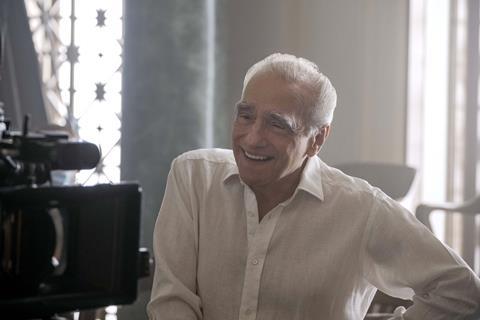
Nominated for nine Baftas and 10 Oscars, Martin Scorsese’s Killers Of The Flower Moon, based on David Grann’s 2017 bestseller Killers Of The Flower Moon: The Osage Murders And The Birth Of The FBI, tells the horrific true story of the killings of Oklahoma’s Osage nation who, in the 1920s, were the richest people per capita in the world, thanks to oil reserves found on their land.
Inevitably, given such wealth, the white man took note, beginning a systemic destruction of the Indigenous population, with outwardly avuncular rancher William ‘King’ Hale (Robert De Niro) the most nefarious. Hale encouraged his dim-witted nephew Ernest Burkhart (Leonardo DiCaprio) to marry Osage heiress Mollie (Lily Gladstone) for her family’s oil rights, then having Ernest spike her insulin, slowly poisoning her. Eventually, the federal authorities responded to the Osage’s plight, sending in FBI agent Tom White (Jesse Plemons) to investigate.
Scorsese and fellow screenwriter Eric Roth’s initial screenplay focused on White’s investigation and was more of a western. But after discussions with the Osage, the pair reconfigured the script to centre on Mollie and Ernest’s relationship. “It was my favourite genre as a child,” muses Scorsese. “The westerns I know are Shane and Red River. I can’t do those things. They also come from a different time and a different world. But that ended with The Wild Bunch. The world changed, for many different reasons. I didn’t know if I could [make a western]. But if I were [to], this would be the perfect one.”
Here, Scorsese, who is Oscar-nominated for best director and best picture, talks Screen International through four key scenes.
Ernest gives a lift to Mollie
The scene: Ernest (DiCaprio) picks up Mollie (Gladstone) in his cab and the two flirt.

Martin Scorsese: “The film was constructed in such a way that I was able to mine what Lily brought. Herself, of course. Her grounded nature. Her being a Native American. Her having very strong convictions about that, and about the history of the Native Americans and the First Nations in Canada. Also, her compassion and open-heartedness. Different levels of good and evil, hatred, love. She really understood that, which made us all feel very comfortable because we’re dealing with a difficult subject.
“Whatever scene she was in, I always expected her to find more. She did this by working with not only Leo and myself, but also with all the Osage on every level — costumes, hair, make-up, history, personal stories. Because many of the characters in the film, most of their families are still there. She was a conduit between us and the Osage, along with other people.
“All this goes into that one scene in the car, which was midway through the shoot. There was a confidence and a good feeling you could sense between Lily and Leo as people, Lily and Leo as actors, and Lily and Leo as Mollie and Ernest. It’s all there in this shot. The very core of their relationship and their trust and love is established in that one shot.
“We learned that [Lily] should do as much Osage as possible, so we added dialogue and changed some to Osage. And out of that came a story from Osage and Native American folklore about the trickster. The trickster being the coyote. There’s a famous story, ‘The coyote and the whirlwind’, where the whirlwind wins. She’s the whirlwind, he’s a coyote. All of that went into that one scene. And she decided to call him coyote. But we didn’t have an ending, so Leo came up with that [line], ‘It must be Indian for handsome devil.’ And when you see her laugh, she’s really laughing. It may seem a simple scene. It’s not. It came together with trust and love and conviction between Lily and Leo. Also, Mollie and Ernest.”
Ernest poisons Mollie
The scene: Ernest comforts Mollie in their bed. Theirs is a complicated relationship. Ernest clearly loves her but, at the same time, administers her insulin laced with poison, at the behest of his uncle.
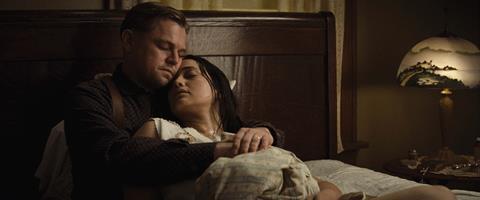
Scorsese: “I’m a Manhattan person, I’m an urban person. When I got [to Oklahoma], I was stunned by the space. I was stunned by the light. By the sky. By the land. Anything could happen [there] and no-one would know. That’s the negative side of the beauty. You’re in a place where there was no law. The law was created and acted upon by the whites who were there. And they were all pretty much corrupted and worked off each other. So, in terms of who knew what, when [in terms of the killings], we were never quite sure. And we felt to specify it would weaken the narrative. Because what I wanted to keep as a strong element of the film was the uncertainty, the uncertainty of crimes committed, and no-one ever knowing who was responsible and how it happened and why.
“When I met with the Osage, they had a big dinner in Gray Horse [in Oklahoma], about 250 of them, and they got up and spoke, and I began to realise that this catastrophe had a face. They were talking about their grandparents and their uncles and their aunts. One person got up and said, ‘You have to understand, Bill Hale and Henry Roan [an Osage man Hale had murdered] were best friends.’ That changed things for me.
“Another person got up, Margie Burkhart, granddaughter of Ernest, and she said, ‘Mollie and Ernest were in love.’ And that stayed with me. I said, ‘If they were in love, how did they all get through this? Did she ever, ever suspect? And if she did suspect, how could she still trust him? And if she did suspect, what did she suspect?’ So, Leo and I decided he should play Ernest [rather than FBI agent White] and we changed the entire script.
“The bottom line is Leo plays a character who plays along with his uncle, but never quite expected it to go that far. It’s not an excuse. Sort of like Marlon Brando’s character in On The Waterfront, with Joey on the roof, in the beginning. He was supposed to call it out and go up on the roof. That’s it. Next thing he knows, the guy got thrown off the roof. He didn’t realise that. He’s still guilty. And when they blow up the house [belonging to Mollie’s sister], Ernest realises he’s in deeper than he thought. And he’s stuck. He’s a weak man. He doesn’t know what to do.
“But he believes he won’t let any harm come to Mollie when he says in the bed, ‘I’m behind you, I’m with you. I’m standing for you.’ That’s why in the scene, after she goes to Washington, and they give him that extra vial of liquid, whatever medicine it is, whatever poison it is, or chemical, he keeps repeating to himself, ‘We’re just going to slow her down.’ He really believes they’re going to slow her down. Consciously. Subconsciously he knows it’s not slowing her down. But he won’t deal with his subconscious. At one point he even takes a sip himself. I don’t think he’s suicidal, but he wants to suffer with her, and for her. She, on the other hand, has only one person to trust, and that’s him.”
Agent White tries to question Bill Hale
The scene: Federal agent Tom White (Plemons) visits Bill Hale (De Niro) in a barber’s chair, to question Hale about the suspicious deaths of several Osage.
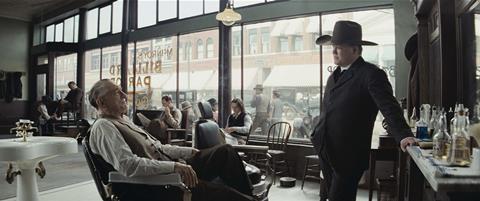
Scorsese: “I saw a shot like that in [Shohei] Imamura’s The Pornographers. It was widescreen black and white. I’ve always been inspired by it, and always tried to get that. In fact, I got a wider shot of Bob, the whole body. But it didn’t work in the dialogue for me, so I went tighter.
“Evil does exist. It’s very much a part of the human condition. And the devil speaks with honey. It’s sweetness. And it’s love. It’s love which is twisted and perverted. And [Hale] does love the Osage. Problem with the Osage is that their time is over. This is Bill speaking, not me. It’s like the decadence of the 19th century in France where you look at a flower, and you appreciate its wilting beauty, the beauty of the decadence. So he appreciates them. He seems to love them. Don’t forget, when the real Bill Hale died, some Osage were at the funeral. Some didn’t believe he did what he was accused of. But he did.
“It’s a perfect example of evil and the delusion he’s not evil. He’s not saying to himself, ‘I’m so evil and I’m enjoying it.’ He feels he’s right and feels he does love them. It’s just history. It’s reality. It’s the passage of cultures. The replacement of one culture over another. And, ‘Why shouldn’t I take advantage and make some money?’ It’s the American way. It’s all about greed. Greed and delusion.
“Bob has said many times, he doesn’t understand him, he doesn’t understand why this man is the way he is. He understands the greed and that greed leads to power. And having that power, you are above the law. He was the king of the Osage Hills. But deep down you don’t have to verbalise it. This is a great actor. He plays it. The verbalising it is for promotion and sometimes for cineastes who are interested, and/or students who want to know how things work in a way.”
Bill Hale sets his fields on fire
The scene: When the net starts to tighten on Ernest and Hale, the latter sets light to his fields to claim the insurance money.
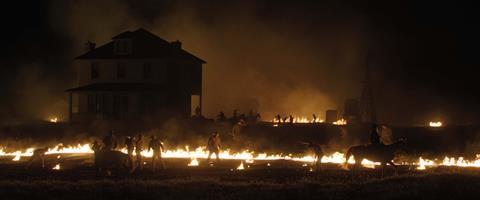
Scorsese: “As Eric Roth and I were working on the script, he pointed out that during this period, when everything was closing in on Bill Hale, he burns the prairies. He burns that land for his insurance money. I said to myself, that’s interesting. With all this trouble around him, he goes out of the way to get more money for the insurance. In a sense he likes playing the game, he’s like a big gambler. Does he need that money?
“People panicked when they saw the land burning, they ran and tried to put it out. I imagined it as a kind of conflagration of all that’s happened in the story. And a conflagration of all that happened with the Europeans coming into the Indigenous world. I imagined European figures dancing around the fire. You see little figures, silhouettes. They’re working [to put it out] but look like they’re dancing. Or is it a macabre dance that comes out of a medieval fresco? Like Giotto’s painting of the demons in hell, so to speak, in his fresco in Padua. I knew that was going to be in the film. Didn’t have to be — but I thought that was important because that summed everything up.
“At the same time, Ernest is giving Mollie the last dosages of what could be poison or too much insulin. We know that insulin can kill. And he has taken a sip of it himself. And there’s an orange glow coming into the room. They’re all descending as low as they could go, in this story. And I thought those images would be the way to do it.
“We even had a dance choreographer work with the men who were the little figures, to be working, trying to put it out, but to make a move that looked like a dance or a kind of tortured feeling, like a scarecrow. It’s hallucinatory. And it was hallucinatory shooting, at night — it was an eerie feeling. A couple of people with me got frightened. And I said, ‘No, everything’s controlled.’ The fires — everything was perfectly controlled. It was very safe. But we’re in the middle of this dark void, in the fields. And it was scary. I kept adding longer lenses and more fire bars in front of the lens to get better [heat] ripples. Then we got tighter and tighter and I saw the images disintegrating. And I said, ‘That’s what we need. Let’s go further.’ It was quite an evening.”













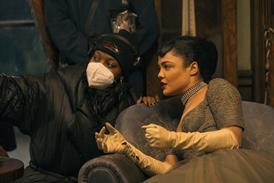
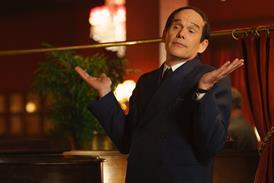








No comments yet